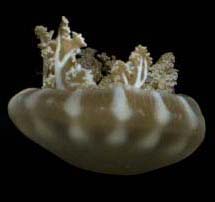
Geographic Range: Indo-Pacific Oceans, also common around Florida and West Indies
Habitat and Behavior: The upside-down jellyfish lives in the sandy mud-flats of shallow water (up to 5m depth). It lies upside-down, anchored on the shallow ocean bottom. While anchored its bell pulses to drive water currents through, carrying respiratory gases and food. The adult upside-down jellyfish rarely swims. They are invertebrates and their bodies are 95% water, 3% salt, and 2% protein. Symbiotic algae living in the jellyfish's body produce oxygen; this allows the jellyfish to survive in oxygen-poor water.
All Images and Text copyright Kristen Frye 2004
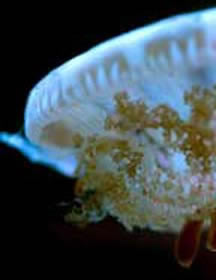
Equipment you will need:
-Digital camera, I used a Nikon D70, but any SLR will do. I don’t suggest using a film capture system because of the amount of images you will be taking.
-Macro lens, I used a Nikon macro 105mm capable of 1:1 in lens magnification.
-Extension tubes, for magnifications greater than your lens can produce on its own.
-Tripod
-Flash system, I used a fiber optics flash system, you may be able to get away with a tungsten light source if it is bright enough for you to shoot at 1/125th or greater.
-dark room and dark clothing to minimize reflection.
How do you photograph a living creature composed of 95% or more of water?
With no skeletal structure jellyfish are extremely delicate and easily damaged. They require the support of an aqueous environment to maintain their shape, without it they are nothing more than unidentifiable jelly-like blobs on the beach. The perfect environment for jellyfish is one without walls, hard objects or anything else that may damage their delicate tissue. In other words, the open ocean. However the open ocean is not the best medium to photograph in. There are too many elements that cannot be controlled. Particles in the water, angle of light and an infinite amount of space for the jellyfish to move in makes getting that perfect shot much more difficult. Not to mention the cost of underwater equipment, and scuba gear. To solve this problem I bought a small 5 ˝ gallon glass tank, instant sea salt and a tank filter*.
The jellyfish themselves were purchased through Ward’s Natural Science www.wardsci.com , and were shipped overnight from California to Rochester New York the day after I ordered them. Other sources of jellyfish are high-end tropical/salt water fish stores. (These stores probably won’t have jellyfish on hand but will be able to special order a greater variety of species than a science/education catalogue such as Wards.)
The tank should be placed in a darkened room, this will minimize the chances of reflections from other light sources. Also remember that since you are photographing through glass it is best to wear dark clothes to reduce the chance of seeing your reflection in your images. Before you begin make sure to clean the inside as well as the outside of the glass. Bubbles and other debris on the inside surface should be wiped some time before the photo session to allow particles a chance to settle out. Suspended particles will reflect light to the camera and show up on your photograph as conspicuous white spots, while these can easily be removed in Photoshop, it’s best to eliminate them from the beginning. You will also want a background, some sort of un-textured, non-reflective dark material, such as a piece of black paper or felt. It should be placed behind the tank where your lights will not illuminate it. Remember the key is to eliminate reflections.
The easiest way I found to light the jellyfish was using a fiber optic flash system. The fiber optics flash unit was fast enough that I could get a crisp shot of the jellyfish but also small enough that I could easily control the amount of light on my subject and background. I positioned the fiber optics so that one end was lighting the jelly fish from above the water's surface, and another end was lighting from the side of the tank. Since the jellyfish are mostly clear you don’t have to be concerned with them casting a shadow. To add colors other than the natural brown and white coloring of the jellyfish I simply used colored gels in front of the strobe units. This lighting technique combined with the black background and clear reflection free tank results in an image of a bright jellyfish on a black background.
From this point on photographing the jellyfish was just a matter of getting them to move into the proper position of my camera frame, while staying in focus. Jellyfish, or any live specimens, are not always the most cooperative models and these particular ones weren’t doing me any favors. By shooting at 1:2 or larger in some images my depth of field was extremely shallow the jellyfish had only a small frame of space where they could swim and still be in focus. One idea I had was to put the jellyfish temporarily into smaller self-made tanks approx 2 square inches wide and 4 inches tall. However, when in a small space this particular species of jellyfish goes to the bottom of the tank and just sits. This makes it very hard to get a good image of a moving jellyfish. The best method I found was to wait patiently for the animals to decide to swim by the lens, and take a lot of images. By the end of my 5-hour shooting session I had shot over 500 images.
Using the above techniques you should be able to get some good images that don’t require much digital manipulation. However since we live in the world of digital everything, these images have been cleaned up a little using Photoshop CS. As hard as I tried, not all of the particle reflections in the tank were eliminated so parts of the backgrounds of these images have been burned in, to make them appear “cleaner.” I also used the “unsharp mask” filter to sharpen these images for viewing on the web.
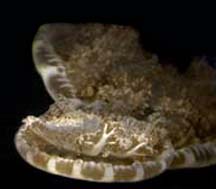
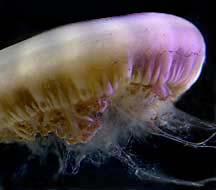
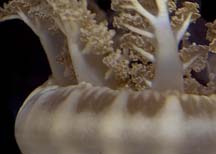
*Most saltwater tank experts suggest a well established round tank with a 30+ gallon capacity, tropical heater, and crushed coral bottom but in this case that was extremely unpractical, as a result the jellyfish did not live more than a couple of days.
.......................................................................................................................................................................................................................
All images and text on this page are copyright Kristen Frye 2004. Thank you for your respect. For permission to use these images or questions or comments about this article write to kristenfrye@gmail.com.
I am currently a fourth year student at the Rochester Institute of Technology, New York, USA majoring in Biomedical Photographic Communications and minoring in Applied Communications. I have completed my photo-concentration in web design and a magazine publishing project. This site is the result of a final project in a photomacrography class taken in fall of 2004. Feel free to visit my website at http://www.rit.edu/~krf0364
November 8th, 2004
For more information on jellyfish and photographing jellyfish visit: